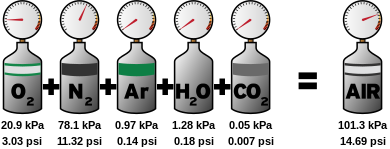
Dalton's law (also called Dalton's law of partial pressures) states that in a mixture of non-reacting gases, the total pressure exerted is equal to the sum of the partial pressures of the individual gases.[1] This empirical law was observed by John Dalton in 1801 and published in 1802.[2] Dalton's law is related to the ideal gas laws.
YouTube Encyclopedic
-
1/5Views:92 091358 9467 96015 683343 055
-
Dalton's Law and Partial Pressures
-
Dalton's Law of Partial Pressure Problems & Examples - Chemistry
-
Daltons Law of Partial Pressure
-
Dalton's Law and Henry's Law
-
Dalton's Law of Partial Pressures Explained
Transcription
Formula
Mathematically, the pressure of a mixture of non-reactive gases can be defined as the summation:
Volume-based concentration
The relationship below provides a way to determine the volume-based concentration of any individual gaseous component
Dalton's law is not strictly followed by real gases, with the deviation increasing with pressure. Under such conditions the volume occupied by the molecules becomes significant compared to the free space between them. In particular, the short average distances between molecules increases intermolecular forces between gas molecules enough to substantially change the pressure exerted by them, an effect not included in the ideal gas model.
See also
- Amagat's law – Gas law describing volume of a gas mixture
- Boyle's law – Relation between gas pressure and volume
- Combined gas law – Combination of Charles', Boyle's and Gay-Lussac's gas laws
- Gay-Lussac's law – Relationship between pressure and temperature of a gas at constant volume
- Henry's law – Gas law regarding proportionality of dissolved gas
- Mole (unit) – SI unit of amount of substance
- Partial pressure – Pressure of a component gas in a mixture
- Raoult's law – Law of thermodynamics for vapour pressure of a mixture
- Vapor pressure – Pressure exerted by a vapor in thermodynamic equilibrium
References
- ^ a b Silberberg, Martin S. (2009). Chemistry: the molecular nature of matter and change (5th ed.). Boston: McGraw-Hill. p. 206. ISBN 9780073048598.
- ^ J. Dalton (1802), "Essay IV. On the expansion of elastic fluids by heat," Memoirs of the Literary and Philosophical Society of Manchester, vol. 5, pt. 2, pages 595–602; see page 600.




